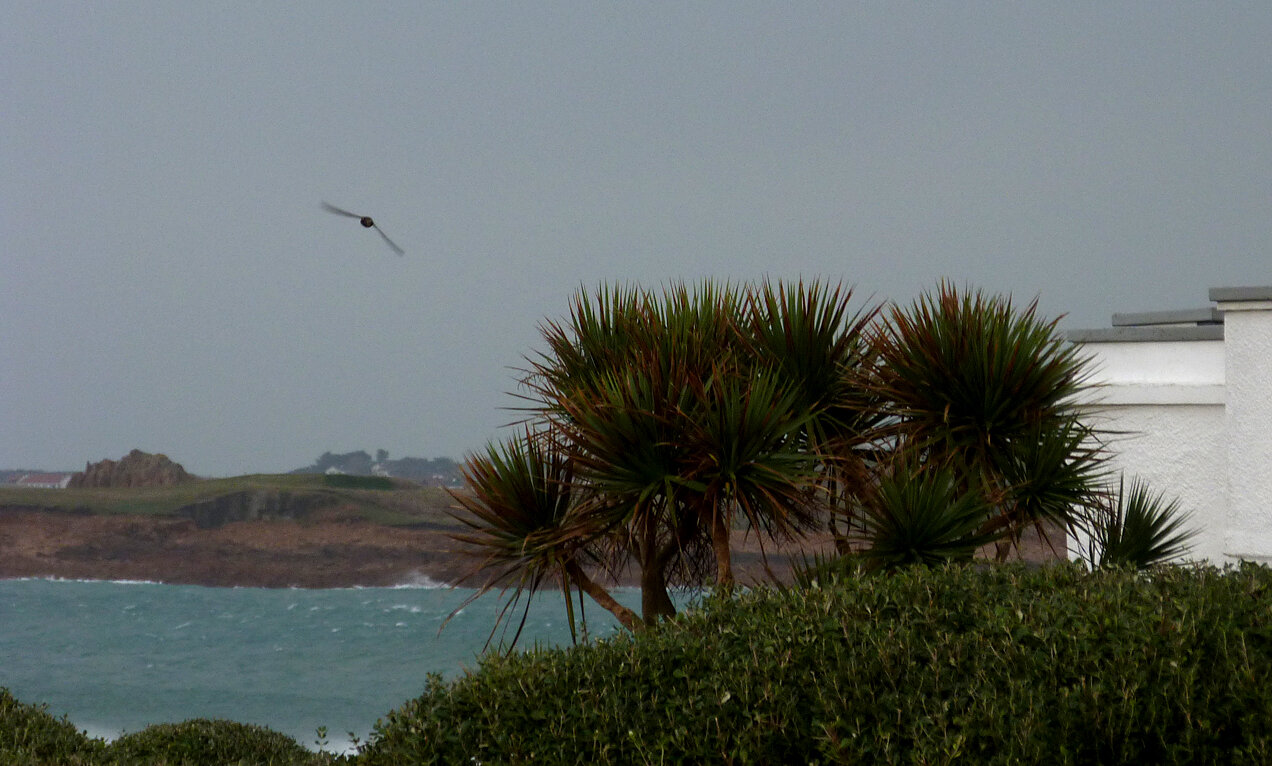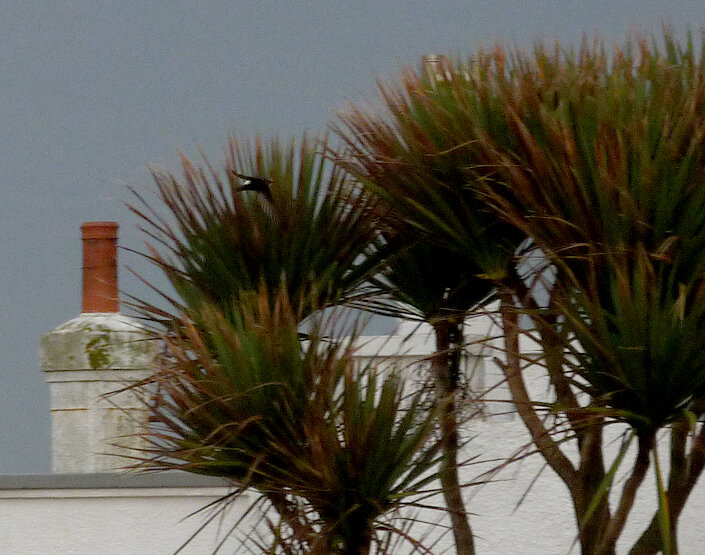Thu 31st December 2015
I had been enjoying my year-end slumber, where I usually slow my birding to crawling pace in the final two months of the year, when all of a sudden with just 2 days to go - KA-BAM!! Yesterday (30th Dec), just as we were having our lunch at home, I got this grapevine message on the phone:
"Richmond - 1 unidentified swift. 'Swift with white rump' (Little?) reported 1210 (JB)"
I nearly spat out my mushroom soup! Little Swift would be amazing, and an unlikely grip-back after the one I dipped on in 2000. Although I was secretly hoping that it maybe was a even White-rumped Swift - a mega-mega! Storm Frank had been sweeping in southerly winds from Africa for the last few days and it really seemed like either species was a possibility. Rosie was asleep after a night shift so I had to quickly get Aidan and Anais ready to come out with me, which stalled my exit. It could've taken them a lot quicker to get sorted - it's almost as if they didn't understand the urgency! Finally getting the kids bundled into the car, we headed down the coast, constantly scanning the skies just in case it was already heading northwards. These swifts can disappear in a flash and so I was nervous that it may already have gone.
Arriving at Richmond, a brief stop saw no swift and no birders, so I drove on to look for either of the two. At Fort le Crocq I immediately saw Mark G by the horse field and I abandoned the car at the long driveway entrance as he started to point towards the house down the slope. I ran over and saw that the swift was flying back and forth, low over the garden and in the shelter of the trees. I still didn't know for certain which species it was and started getting all giddy! Soon though it became obvious that it was indeed a Little Swift - a hugely wanted bird for my British List.
It was flying so fast back and forth, it was difficult to keep it in the bins most of the time, never mind trying to get a photo (as can be seen from the poor efforts below). It was so windy that the bird was keeping very low behind a stand of conifers and often at ground floor height. Its sheltered feeding area was mostly a private property and so the birders which were now starting to arrive couldn't get very close to the bird, although every now and again, it came closer where you could see all the salient features.
Little Swift - Fort Le Crocq, 30 Dec 15
The most obvious feature was the large white rump patch which was even visible when the bird was quite high up. It was clearly smaller than a Common Swift, but still larger than I expected - when it is called "Little" Swift, you imagine it is really small, House Martin-sized or similar. I had seen the species before, about 21 years ago in Israel, but I've not seen one since as it is a bloney rare bird in the UK still. I had written off this species as one I would never get back on the handful of people who saw the last one in Guernsey, but this is now the third for the Channel Islands, in just 15 years.
After a while I returned to the car where the kids were being exceptionally patient and drove to the proper car park where we all got out for a wander. I pointed out the swift to Aidan and he saw it flying around. He's not up to speed with birding yet, but it's now the rarest bird he's seen.
On this photo you can see that the tail on the Little Swift is not forked at all but square-ended, and when fully-spread looks rounded. Also the wings are obviously pinched-in close to the body.
The rump on a Little Swift is very extensive and spreads onto the rear flanks a little way, which means it is visible even from below like in the photo above.
Just as I was getting the kids sorted for a quick walk along the rocky beach off the end of the headland, the gathered crowd started gesticulating towards me. I span round and round and then realised that the swift was right above my head, just a few metres away! It looked me right in the eye and seemed to be saying "respect bro'. It was just so exciting - I've not had a proper twitch like this for ages - not for anything I needed for Britain anyway. As I played with the kids on the sand, the swift continued feeding low over the exposed rocks and rockpools below where we all stood. Unfortunately I couldn't stay much longer, although I would have liked to and headed back home.
You can't really see it on any of the photos but the bird had quite a bit of white around the face, quite obvious in the bins, more so than in a Common Swift.
So how had this bird got here? Little Swifts are of course really rare and don't breed any closer than Morrocco, which is quite a way to go. Also, this is the middle of winter and swifts are summer birds, there has never been one in December in Britain before, so what is going on? The most obvious thing is to blame Frank the Storm. apparently, Frank is one of the deepest lows ever to cross the Atlantic and, although the centre of the storm went north of the UK, the winds caused by this vortex start way, way down south. This is the reason it is so mild this winter so far - the air above us was, not long ago, above the desert. There has been lots of African moths been blown to the UK in the last couple of weeks, so why not an African bird? These recent crazy weather patterns may not be good for the world, but they do bring interesting birds!
The Little Swift has eclipsed everything else in November and December, but I have been seeing a few good birds, even though I haven't spent many hours in the field. The day after I arrived home from England (31st Oct) Rosie was leaving the drive in the car and saw something belt across in front of her and towards our house. I investigated and found a Water Rail cowering underneath our electric box and across the driveway a cat looking on with interest! The cat had been clearly chasing it. I tried to reach my hand under the box, but before I was even close, it shot out at great speed, running out of the drive and into the road! Then the cat shot out after it! - then I belted out after them both! - then a car appeared coming down the street! It was like some kind of Benny Hill sketch. Luckily I shouted at the cat and it scarpered, the car overtook and missed the rail and I managed, with some good fortune, to reach down and grab the bird one handed! Like I was Harry Potter catching the Golden Snitch. The bird seemed OK, so I took it down to the marshland behind the school. Not a bad bird for the garden list!
Water Rail - garden, 31 Oct 15
On 10th Nov I had a late Wheatear on the beach at Pulias and the wintering Great Northern Diver returned to the Rousse area. On the Saturday of 21st Nov there was a big northerly blow and a few of us cowered in the seawatching hide at Chouet to see if anything was passing, despite the regular soaking from the rain coming straight in on us from the sea. As the wind was so strong it was pushing birds very close to land and most of what we saw was closer than the reef . At least 300 Kittiwakes went past us and lots of Gannets of course. We had 5 Sooty Shearwaters, plus 21 Great Skuas and we managed a single dark Pomarine Skua, the highlight of a terrific late seawatch.
Pheasant - Fort Hommet, 23 Nov 15 - pretending to be a Red Grouse
On 29th Nov there was a grapevine message of a Whooper Swan at the Reservoir, and since I was free I went to see it. I had not had one in Guernsey for at least ten years and so it was good to see it, despite it being not very exciting. I was surprised that there were only a couple of us there and that it wasn't twitched by lots of the local birders. Only after a while did I remember that there had been a couple at L'Eree around Easter time, when I was away I think, and so it wouldn't even be a year tick for most people.
Whooper Swan - Reservoir, 29 Nov 15
Early December is often the quietest time of year for birding and I didn't really see anything. However on 18th, my final day of work, early in the morning I was driving in the dim light past Cobo, when I saw a long-winged, odd-shaped bird over the car, from the direction of the playing fields. Bleary-eyed, I didn't realise what it was at first, but soon identified it as a Short-eared Owl, especially after it started getting some stick from a couple of corvids. It flapped out over the bay but I lost it and didn't know whether it kept going out to sea. There was a Water Pipit at Fort Le Crocq on 21st.
Marsh Harrier - Rue des Hougues, 9 Dec 15
Pholcus phalagioides - inside house, 26 Dec 15
After a mention on facebook, I looked up some photo stacking software called 'Zerene' and noticed that they had a free month's trial. One of the problems with macro photos is getting all the creature in focus, due to a narrow depth of field. For example, in the spider photo above, although the head is in focus, the legs and the body are nowhere near. So I downloaded the trial version and tried it on a few of my specimens and it works very well - you just take as many photos as possible focussing on different parts of the body, and the program merges them together for you automatically. It seems to work well, although you cannot move the camera even a fraction or the pics don't line up properly, and so a tripod is needed. A couple of examples of my first attempts are below, but it will be difficult with live specimens!
Reticulate Blood Bee - St Sampsons HS area, 17 Aug 15
Great Banded Furrow Bee - St Sampsons HS area, 17 Aug 15















